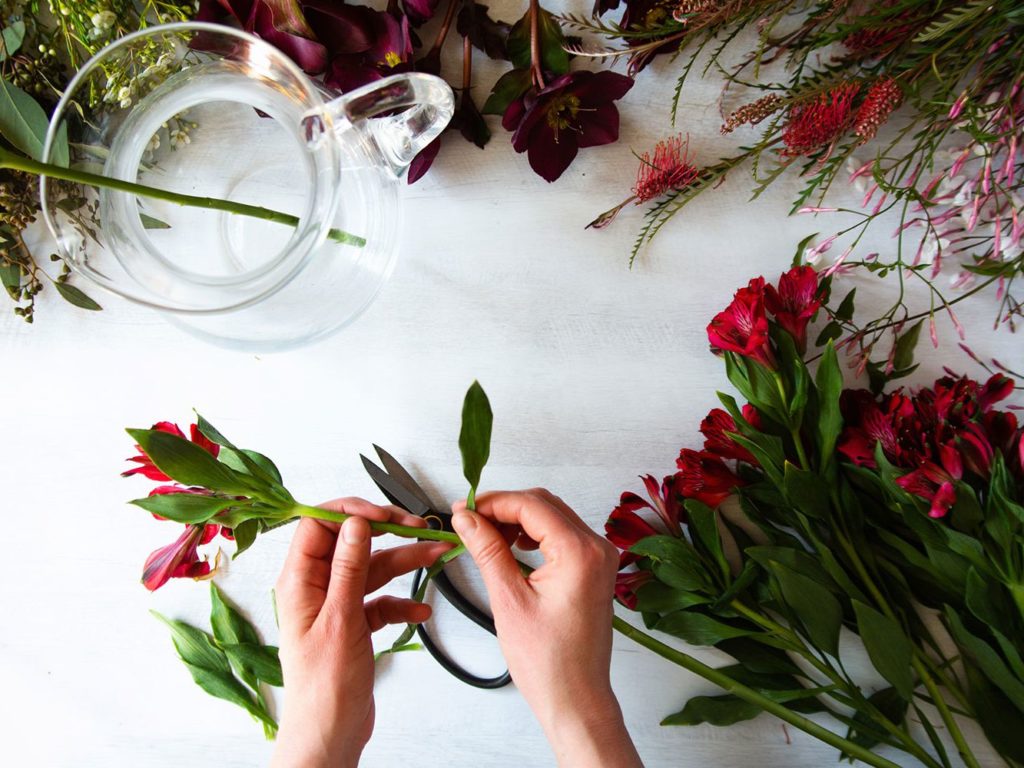Organizing flowers takes a tad of creative capacity. Yet, more than that, it takes some information on what goes into making an essential flower plan that is outwardly engaging and will keep going as far as might be feasible.
Organizing your Flower bouquets like an ace takes some training, so if it’s not too much trouble, go get yourself a few flowers and practice alongside this illustration. You’ll learn something while you partake in the flowers you just got for yourself!
Perhaps the most effective way to choose how to organize Birthday flower bouquets is to observe a plan that you like and attempt to reproduce it. It is beyond the realm of possibilities to expect to show you without question, everything there to flower orchestrating in this course, you will in any case dominate probably the least demanding and most tasteful plans that will dazzle your companions and ideally your new clients.
Keep it Simple
Use as need might arise for a course of action. That’s it. No less. Try not to add every one of the flowers you have available to you. Likewise, keep away from not utilizing an adequate number of flowers. The two errors are indications of a beginner.
Half and half Tabletop Technique
This first strategy is intended to give an answer for a typical issue with flowers that have straight, however adaptable stems. Typically, when you place these flowers in a jar, they simply hang over and decline to remain set up.
Similarly, as with all the accompanying organizing methods, I am accepting that you will begin with flowers that are cleaned, watered, and took care of. Never avoid that piece of the cycle! Begin with a decent pack of flowers. I’m exhibiting this with the long-stemmed alstroemeria, yet it tends to be finished with a wide range of flowers. Hyacinths settle on a decent decision, as do both standard and smaller than expected calla lilies. As a matter of fact, utilizing standard size white calla lilies is one of the most exemplary introductions of this plan!
Since this method features the whole flower, bloom and stem, you will need to utilize an unmistakable jar so the masterfulness of the stems is noticeable.
Stage 1:
- Arrange your cleaned and took care of flowers before you as such. Pick the tallest, straightest stem and spot it in the middle.
- As you take a gander at your flowers, you will see that a portion of the blooms incline toward the right.
- A portion of the blooms incline toward the left.
- Try not to battle Mother Nature. Permit the flower to do what it needs to do. Place that multitude of blooms that are reallyinclining toward the right on the right hand side. Those blooms reallyinclining toward the left will be put on the left hand side.
- You will put the flowers on top of each other, keeping the tall straight ones in the middle, and running after the formation of a sort of pyramid before you.
- At the point when you like how the flowers are organized, snatch every one of the stems along with your non-predominant hand and hold them solidly together.
Stage 2:
- Here you can see that the closures are very lopsided.
- This will occur in nature.
- All you want to do is to manage them.
- Utilizing your trimmers or the copper (in the event that you’re adequately fortunate to have one) and cut the stems straight across the base.
Stage 3:
- Measure against the jar you plan to utilize. You need the flowers to be only several crawls over the edge of the container.
Stage 4:
- Now, hold the stems at both the highest point of the stems, just under where the flowers are, and your other hand will be at the lower part of the stems.
- With a bend, one hand contorting (tenderly!) in one heading, the other hand winding in the other course, you will make the stems structure a twisting shape.
- This should bring about an impeccably adjusted contort that is trademark for this orchestrating method.
- It might two or three attempts, however you’ll get its hang!
- Here is what this game plan resembles when it is finished.
- Notice that the flower blooms make an adjusted overhang of blooms, with the tallest ones in the middle. Those blooms still up in the air to twist some heading are currently impeccably adjusted.
- The stems are tenderly wound in the container giving you more to take a gander at than essentially the flowers. This has now turned into a show-stopper.
- Keen on finding out additional? Why not take an internet based Floral Arrangement course?
- The straightforwardness of the reasonable container and the water level finishes this plan style.
Mixture Matrix Technique
- While you’re hoping to orchestrate thick, woody stems like roses, a great many people are leaned to just power them into a jar where they will stand upstanding, looking precisely as though you have recently thudded them into a jar.
- The cross breed grid strategy permits you to work with the flowers, their tendency, and their defects to make a work of art and stunning showcase that is so natural, you will have a hard time believing it.
- Before you start, once more, ensure your flowers are cleaned, molded, and rested. Start by setting one flower at a corner to corner into the holder.
- You will be working in a clockwise way, and you’ll put each resulting stem into the jar under the past stem. This will assist each flower with leaning effectively against the one going before, with satisfactory space for the blooms to look organized, yet loose.
- As you proceed, you will make a framework or a design under that will thusly uphold each line as you fabricate the game plan.
- At the point when you start to arrive at the finish of the plan, it isn’t important to go on with the example. Presently you’re hoping to make up for in any shortcomings on the top, where the flower blooms are.
- I generally place the tallest and straightest stems in the middle as the last flowers to be set up.
- This is what the framework resembles in an enormous bowl with stems around 24 inches long.
- We should look again at the very same strategy in a more modest jar with more limited stems.

Stage 1 :
- Layout your stems and slice them all to about a similar length.
- Here I am utilizing a 6 inch square glass jar and I slice the stems to around 10 crawls to begin, cutting every one as I embed it into the jar.
- Coincidentally, you will require around 24 roses to finish this look! I know, such a little container, thus many flowers! Isn’t unreasonably great? You’ll be so content with the look that you will make this one over and over.
Stage 2 :
- As we began with the past model with the long-stemmed pink roses, start by putting your initial flower at an inclining into a furthest corner.
- Since you’re working with a square jar, you will need to manage each stem as you embed this is on the grounds that those set at a slanting into a corner should be longer than the ones put against a level side.
- Keep in mind, work clockwise, and place each stem under the one you just situated before it.
Stage 3 :
- Once you have eight or nine roses set up, making the external line, you will start to work the other way!
- Put around eight or nine roses on top of the first framework yet work counterclockwise at this point. You will actually want to notice the production of the framework through the glass, and you can now perceive how solid and stable this kind of a course of action truly is.
- The following are two photographs of the finished plan.
- The first is totally unadorned, with just the roses as the embellishment. Isn’t excessively basically rich?
- The subsequent photograph shows that you can put a smidgen of vegetation under the base column of flowers, relaxing the edge, giving it a little gentler, more heartfelt look.
- Presently we will make a network in the very container that we utilized with the alstroemeria. Recall how we involved them for the cross breed tabletop procedure? This model is to exhibit the way in which you can involve the lattice procedure in any size or formed holder.
- Once more, you start by putting a solitary stem at an inclining, and afterward you keep working clockwise until you have eight or nine stems set up.
- As may be obvious, this makes an alternate look from the crossover tabletop strategy, which is the delicately curving of the stems.
- Nonetheless, the two of them make wonderful interest in both the blooms on the top and the stems that are noticeable through the jar.
- Both of these procedures are done superbly with silks and afterward adding the acrylic or urethane “water”. You will have made a thing of beauty you can appreciate for quite a long time!
Settling and Wiring Flowers
- Whenever you are working with flowers, there will come when you totally should compel a flower to adapt to your will.
- This can be achieved by wiring flowers with botanical wire, stem picks, and flower tape.
- This is a fundamental expertise that once mastered will be utilized again and again. In the image above, we are wiring cymbidium orchids to be utilized in a wedding highlight.
- Cymbidium orchids are an amazing decision for wiring in light of the fact that their stem is something like 2 or 3 inches long, and they keep going a long, long break of water. That makes them an extraordinary number one with ladies and individuals who intend to wear a corsage to an occasion that will most recent a few hours.
- To begin with, accumulate your materials. Here we have six inch bits of 26 check wire, wire trimmers, botanical tape and an arrangement of leaves and flowers.
- All things considered, this is the start of how to make a boutonniere. You’ll figure out how to do this in a later illustration, yet it is vital to comprehend that this is the underlying advance, the bones of the boutonniere or corsage.















